Climatology of the Combined ASTER MODIS Emissivity over Land (CAMEL) Version 2
Abstract
1. Introduction
2. Data and Software
2.1. CAMEL V002
2.2. Other Data
3. Changes in CAMEL V002 from V001
4. CAMEL Climatology Description and Methodology
5. Results
5.1. Case Site Analyses
5.2. Analyses Stratified by IGBP Land Cover Class
5.3. Global Temporal Emissivity Variation
6. Evaluation Using RTTOV Calculations and IASI Observations
6.1. Case Sites
6.2. Four Case Days
7. Preliminary Comparison with ECOSTRESS
8. Conclusions
Author Contributions
Funding
Data Availability Statement
Acknowledgments
Conflicts of Interest
References
- Feltz, M.; Borbas, E.; Knuteson, R.; Hulley, G.; Hook, S. The combined ASTER and MODIS emissivity over land (CAMEL) global broadband infrared emissivity product. Remote Sens. 2018, 10, 1027. [Google Scholar] [CrossRef]
- Cheng, J.; Liang, S.; Yao, Y.; Zhang, X. Estimating the optimal broadband emissivity spectral range for calculating surface longwave net radiation. IEEE Geosci. Remote Sens. Lett. 2013, 10, 401–405. [Google Scholar] [CrossRef]
- Bonan, G.B.; Oleson, K.W.; Vertenstein, M.; Levis, S.; Zeng, X.; Dai, Y.; Dickinson, R.E.; Yang, Z. The Land Surface Climatology of the Community Land Model Coupled to the NCAR Community Climate Model. J. Clim. 2002, 15, 3123–3149. [Google Scholar] [CrossRef]
- Zhou, L.; Dickinson, R.E.; Tian, Y.; Jin, M.; Ogawa, K.; Yu, H.; Schmugge, T. A sensitivity study of climate and energy balance simulations with use of satellite-derived emissivity data over Northern Africa and the Arabian Peninsula. J. Geophys. Res. 2003, 108, 4795. [Google Scholar] [CrossRef]
- Jin, M.L.; Liang, S.L. An Improved Land Surface Emissivity Parameter for Land Surface Models Using Global Remote Sensing Observations. J. Clim. 2006, 19, 2867–2881. [Google Scholar] [CrossRef]
- Thrastarson, H.T.; Manning, E.; Kahn, B.; Fetzer, E.J.; Yue, Q.; Wong, S.; Kalmus, P.; Payne, V.; Olsen, E.T.; Wilson, R.C.; et al. AIRS/AMSU/HSB Version 7 Level 2 Product User Guide; Jet Propulsion Laboratory, California Institute of Technology: Pasadena, CA, USA, 2020.
- Yao, Z.G.; Li, J.; Li, J.L.; Zhang, H. Surface Emissivity Impact on Temperature and Moisture Soundings from Hyperspectral Infrared Radiance Measurements. J. Appl. Meteorol. Clim. 2011, 50, 1225–1235. [Google Scholar] [CrossRef]
- Hulley, G.C.; Hook, S.J.; Abbott, E.; Malakar, N.; Islam, T.; Abrams, M. The ASTER Global Emissivity Dataset (ASTER GED): Mapping Earth’s emissivity at 100 meter spatial scale. Geophys. Res. Lett. 2015, 42, 7966–7976. [Google Scholar] [CrossRef]
- Wan, Z.; Li, Z.-L. A physics-based algorithm for retrieving land-surface emissivity and temperature from eos/modis data. IEEE Trans. Geosci. Remote Sens. 1997, 35, 980–996. [Google Scholar] [CrossRef]
- Hulley, G.C.; Malakar, N.K.; Islam, T.; Freepartner, R.J. NASA’s MODIS and VIIRS Land Surface Temperature and Emissivity Products: A Long-Term and Consistent Earth System Data Record. IEEE J. Sel. Top. Appl. Earth Obs. Remote Sens. 2018, 11, 522–535. [Google Scholar] [CrossRef]
- Hulley, G.; Veraverbeke, S.; Hook, S. Thermal-based techniques for land cover change detection using a new dynamic MODIS multispectral emissivity product (MOD21). Remote Sens. Environ. 2014, 140, 755–765. [Google Scholar] [CrossRef]
- Seemann, S.W.; Borbas, E.E.; Knuteson, R.O.; Stephenson, G.R.; Huang, H.-L. Development of a Global Infrared Land Surface Emissivity Database for Application to Clear Sky Sounding Retrievals from Multispectral Satellite Radiance Measurements. J. Appl. Meteorol. Climatol. 2008, 47, 108–123. [Google Scholar] [CrossRef]
- Borbas, E.E.; Seemann, S.W. Global Infrared Land Surface Emissivity: UW-Madison Baseline Fit Emissivity Database V2.0. 2007. Available online: http://cimss.ssec.wisc.edu/iremis/ (accessed on 28 November 2020).
- Zhou, D.K.; Larar, A.M.; Liu, X.; Smith, W.L.; Strow, L.L.; Yang, P.; Schlussel, P.; Calbet, X. Global land surface emissivity retrieved from satellite ultraspectral IR measurements. IEEE Trans. Geosci. Remote Sens. 2011, 49, 1277–1290. [Google Scholar] [CrossRef]
- Péquignot, E.; Chédin, A.; Scott, N.A. Infrared continental surface emissivity spectra retrieved from AIRS hyperspectral sensor. J. Appl. Meteorol. Climatol. 2008, 47, 1619–1633. [Google Scholar] [CrossRef]
- Capelle, V.; Chédin, A.; Péquignot, E.; Schlüssel, P.; Newman, S.M.; Scott, N.A. Infrared continental surface emissivity spectra and skin temperature retrieved from IASI observations over the tropics. J. Appl. Meteorol. Climatol. 2012, 51, 1164–1179. [Google Scholar] [CrossRef]
- Paul, M.; Aires, F.; Prigent, C.; Trigo, I.F.; Bernardo, F. An innovative physical scheme to retrieve simultaneously surface temperature and emissivities using high spectral infrared observations from IASI. J. Geophys. Res. Atmos. 2012, 117. [Google Scholar] [CrossRef]
- Huang, X.; Chen, X.; Zhou, D.K.; Liu, X. An observationally based global band-by-band surface emissivity dataset for climate and weather simulations. J. Atmos. Sci. 2016, 73, 3541–3555. [Google Scholar] [CrossRef]
- Hook, S. Combined ASTER and MODIS Emissivity Database over Land (CAMEL) Uncertainty Monthly Global 0.05Deg V002 [Data Set]; NASA EOSDIS Land Processes DAAC, USGS Earth Resources Observation and Science (EROS) Center: Souix Falls, SD, USA, 2019. [CrossRef]
- Hook, S. Combined ASTER and MODIS Emissivity Database over Land (CAMEL) Emissivity Monthly Global 0.05Deg V002 [Data Set]; NASA EOSDIS Land Processes DAAC, USGS Earth Resources Observation and Science (EROS) Center: Souix Falls, SD, USA, 2019. [CrossRef]
- Hook, S. Combined ASTER and MODIS Emissivity Database over Land (CAMEL) Coefficient Monthly Global 0.05Deg V002 [Data Set]; NASA EOSDIS Land Processes DAAC, USGS Earth Resources Observation and Science (EROS) Center: Souix Falls, SD, USA, 2019. [CrossRef]
- Borbas, E.; Hulley, G.; Feltz, M.; Knuteson, R.; Hook, S. The Combined ASTER MODIS Emissivity over Land ( CAMEL ) Part 1: Methodology and High Spectral Resolution Application. Remote Sens. 2018, 10, 643. [Google Scholar] [CrossRef]
- Feltz, M.; Borbas, E.; Knuteson, R.; Hulley, G.; Hook, S. The Combined ASTER MODIS Emissivity over Land ( CAMEL ) Part 2: Uncertainty and Validation. Remote Sens. 2018, 10, 664. [Google Scholar] [CrossRef]
- Hulley, G.; Hook, S. AG5KMMOH: ASTER Global Emissivity Dataset, Monthly, 0.05 Degree, HDF5 V041 [Dataset]; NASA EOSDIS Land Processes DAAC, USGS Earth Resources Observation and Science (EROS) Center: Souix Falls, SD, USA, 2016. [CrossRef]
- Borbas, E.E.; Ruston, B.C. The RTTOV UWiremis IR land surface emissivity module. In Mission Report NWPSAF-MO-VS-042, EUMETSAT Numerical Weather Prediction Satellite Applications Facility; Met Office: Exeter, UK, 2010. Available online: http://research.metoffice.gov.uk/research/interproj/nwpsaf/vs_reports/nwpsaf-mo-vs-042.pdf (accessed on 28 November 2020).
- Borbas, E. The RTTOV UWiremis module Investigation into the angular dependence of IR surface emissivity. In Mission Rep. NWPSAF-MO-VS-50 EUMETSAT Numerical Weather Prediction Satellite Applications Facility; Met Office: Exeter, UK, 2014. Available online: https://nwpsaf.eu/vs_reports/nwpsaf-mo-vs-050.pdf (accessed on 28 November 2020).
- Saunders, R.; Hocking, J.; Rundle, D.; Rayer, P.; Havemann, S.; Matricardi, M.; Geer, A.; Cristina, L.; Brunel, P.; Vidot, J. RTTOV-12 Science and Validation Report. In Mission Rep. NWPSAF-MO-TV-41, EUMETSAT Numerical Weather Prediction Satellite Applications Facility; Met Office: Exeter, UK, 2017. Available online: https://nwpsaf.eu/site/download/documentation/rtm/docs_rttov12/rttov12_svr.pdf (accessed on 28 November 2020).
- Saunders, R.; Hocking, J.; Turner, E.; Rayer, P.; Rundle, D.; Brunel, P.; Vidot, J.; Roquet, P.; Matricardi, M.; Geer, A.; et al. An update on the RTTOV fast radiative transfer model (currently at version 12). Geosci. Model Dev. 2018, 11, 2717–2737. [Google Scholar] [CrossRef]
- Borbas, E.E.; Feltz, M.L. Updating the CAMEL Surface Emissivity Atlas for RTTOV. In Rep. Visit. Sci. Mission NWP_AS18_01, EUMETSAT Numerical Weather Prediction Satellite Applications Facility; Met Office: Exeter, UK, 2019. Available online: https://www.nwpsaf.eu/publications/vs_reports/nwpsaf-mo-vs-058.pdf (accessed on 28 November 2020).
- Borbas, E.E.; Hulley, G.C.; Knuteson, R.O.; Feltz, M.L. MEaSUREs Unified and Coherent Land Surface Temperature and Emissivity (LST&E) Earth System Data Record (ESDR): The Combined ASTER and MODIS Emissivity Database Over Land (CAMEL) Version 2 Users’ Guide. 2019. Available online: https://lpdaac.usgs.gov/documents/219/cam5k30_v2_user_guide_atbd.pdf (accessed on 17 July 2020).
- Friedl, M.; Sulla-Menashe, D. MCD12C1 MODIS/Terra+Aqua Land Cover Type Yearly L3 Global 0.05Deg CMG V006 [Data Set]; NASA EOSDIS Land Processes DAAC, USGS Earth Resources Observation and Science (EROS) Center: Souix Falls, SD, USA, 2015. [CrossRef]
- Friedl, M.A.; Sulla-Menashe, D.; Tan, B.; Schneider, A.; Ramankutty, N.; Sibley, A.; Huang, X. MODIS Collection 5 global land cover: Algorithm refinements and characterization of new datasets. Remote Sens. Environ. 2010, 114, 168–182. [Google Scholar] [CrossRef]
- Channan, S.; Collins, K.; Emanuel, W.R. Global Mosaics of the Standard MODIS Land Cover Type Data; University of Maryland and the Pacific Northwest National Laboratory: College Park, MD, USA, 2014.
- Hulley, G.; Hook, S. ECOsystem Spaceborne Thermal Radiometer Experiment on Space Station (ECOSTRESS) Mission Level 2 Land Surface Temperature and Emissivity Algorithm Theoretical Basis Document; NASA Jet Propulsion Laboratory, California Institute of Technology: Pasadena, CA, USA, 2016. Available online: https://ecostress.jpl.nasa.gov/downloads/atbd/ECOSTRESS_L2_ATBD_LSTE_2018-03-08.pdf (accessed on 28 November 2020).
- Hook, S.; Hulley, G. ECOSTRESS Land Surface Temperature and Emissivity Daily L2 Global 70 m V001 [Data Set]; NASA EOSDIS Land Processes DAAC, USGS Earth Resources Observation and Science (EROS) Center: Souix Falls, SD, USA, 2019. [CrossRef]
- Desroziers, G.; Berre, L.; Chapnik, B.; Poli, P. Diagnosis of observation, background and analysis-error statistics in observation space. Q. J. R. Meteorol. Soc. 2005, 131, 3385–3396. [Google Scholar] [CrossRef]
- Wang, L.; Goldberg, M.; Wu, X.; Cao, C.; Iacovazzi, R.A.; Yu, F.; Li, Y. Consistency assessment of Atmospheric Infrared Sounder and Infrared Atmospheric Sounding Interferometer radiances: Double differences versus simultaneous nadir overpasses. J. Geophys. Res. 2011, 116. [Google Scholar] [CrossRef]
- Lavanant, L. MAIA AVHRR Cloud Mask and Classification; Météo-France CMS: Lannion, France, 2002. [Google Scholar]
- Hulley, G.C.; Goettsche, F.; Rivera, G.; Hook, S.; Freepartner, R.; Radocinski, R.; Martin, M.; Cawse-Nicholson, K.; Johnson, W. Validation and quality assessment of the ECOSTRESS level-2 land surface temperature and emissivity product. Remote Sens. Environ. 2020. in review. [Google Scholar]
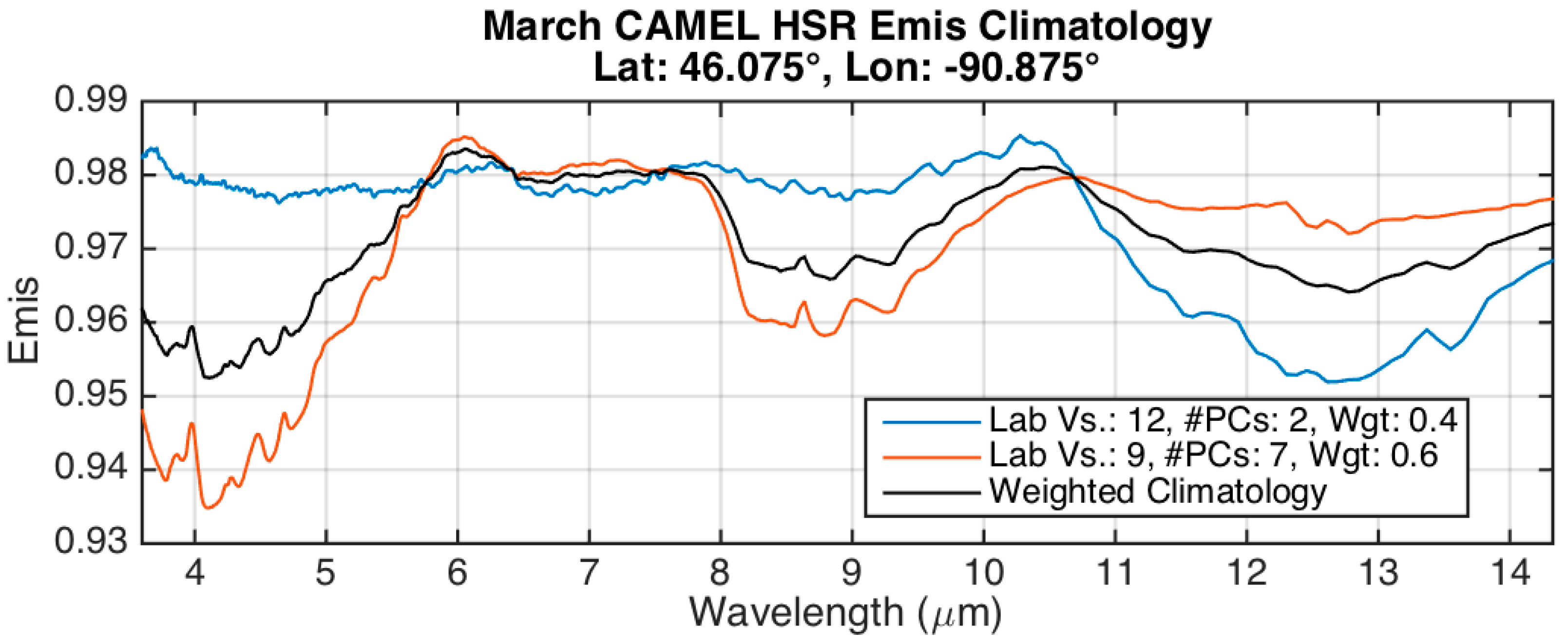
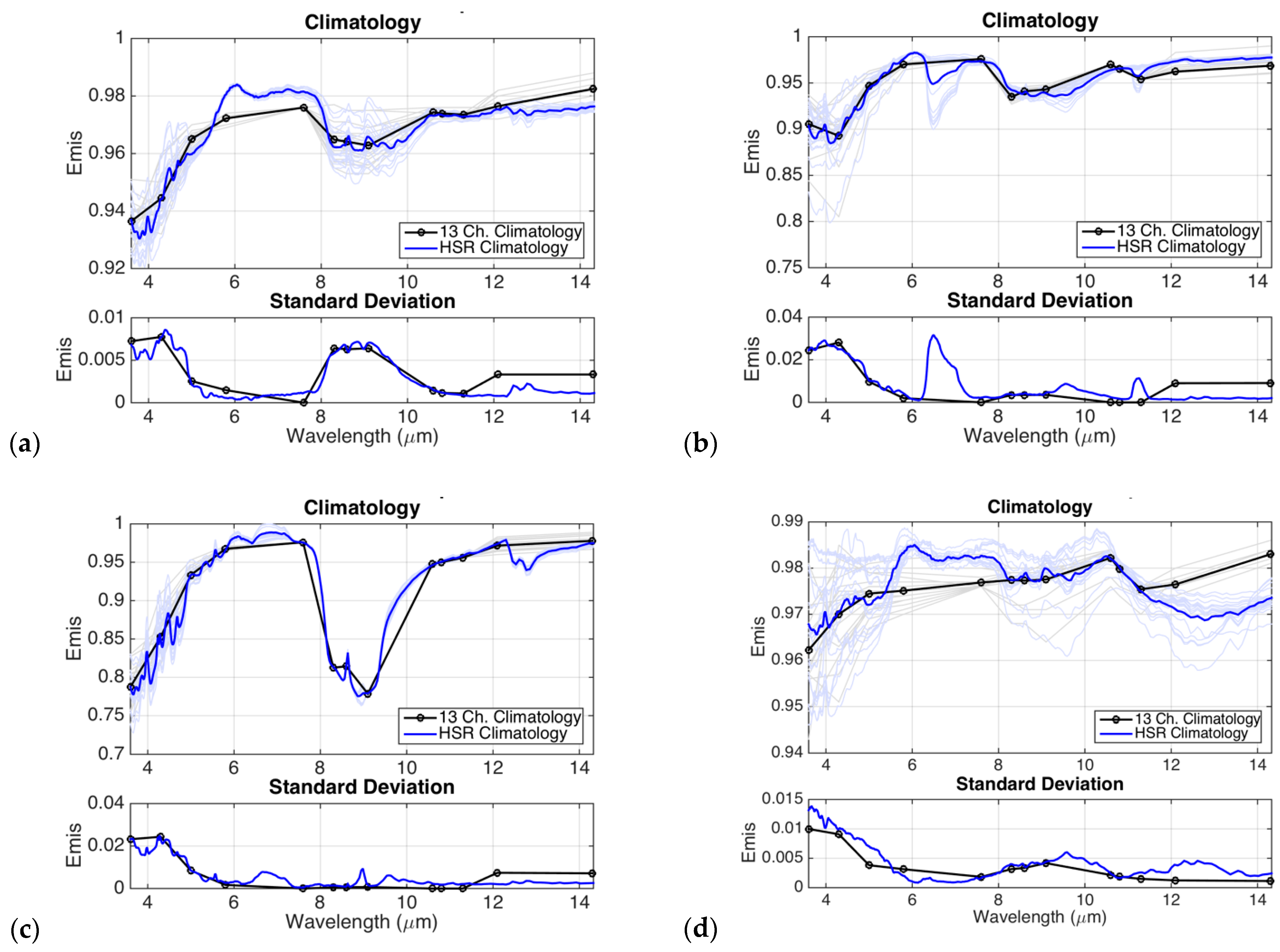
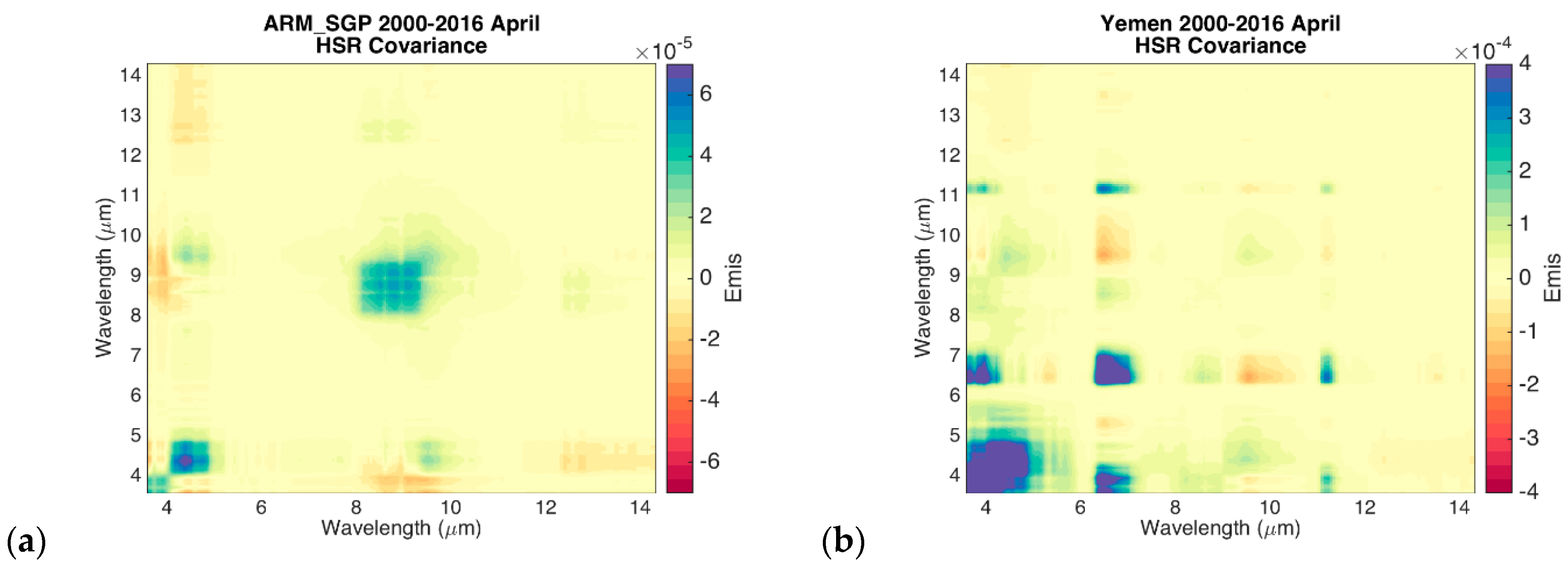
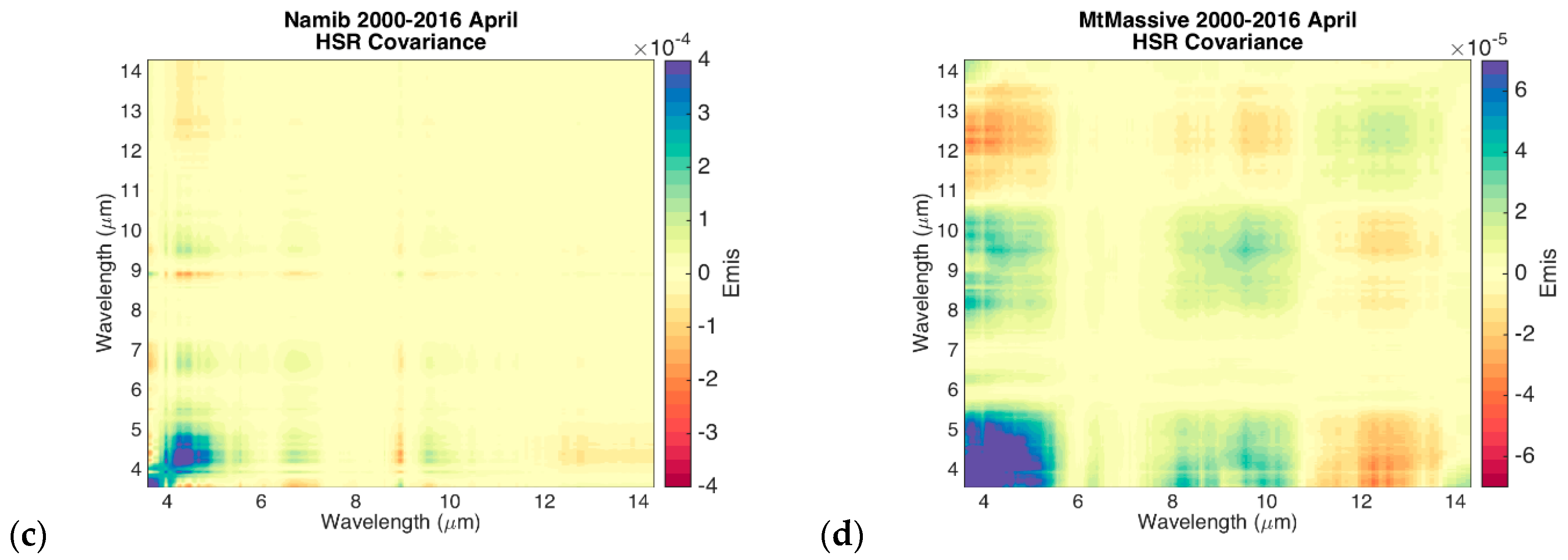
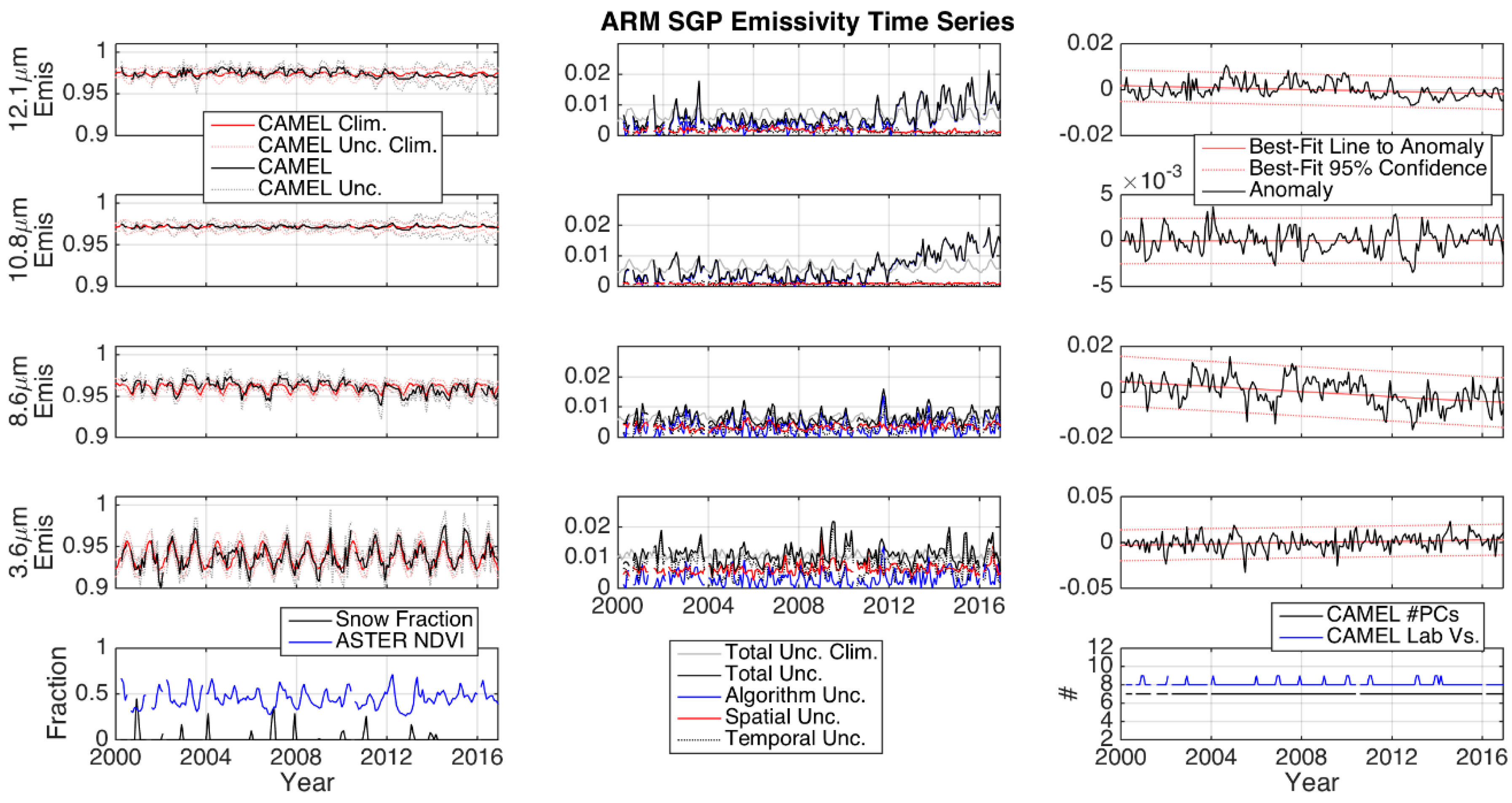

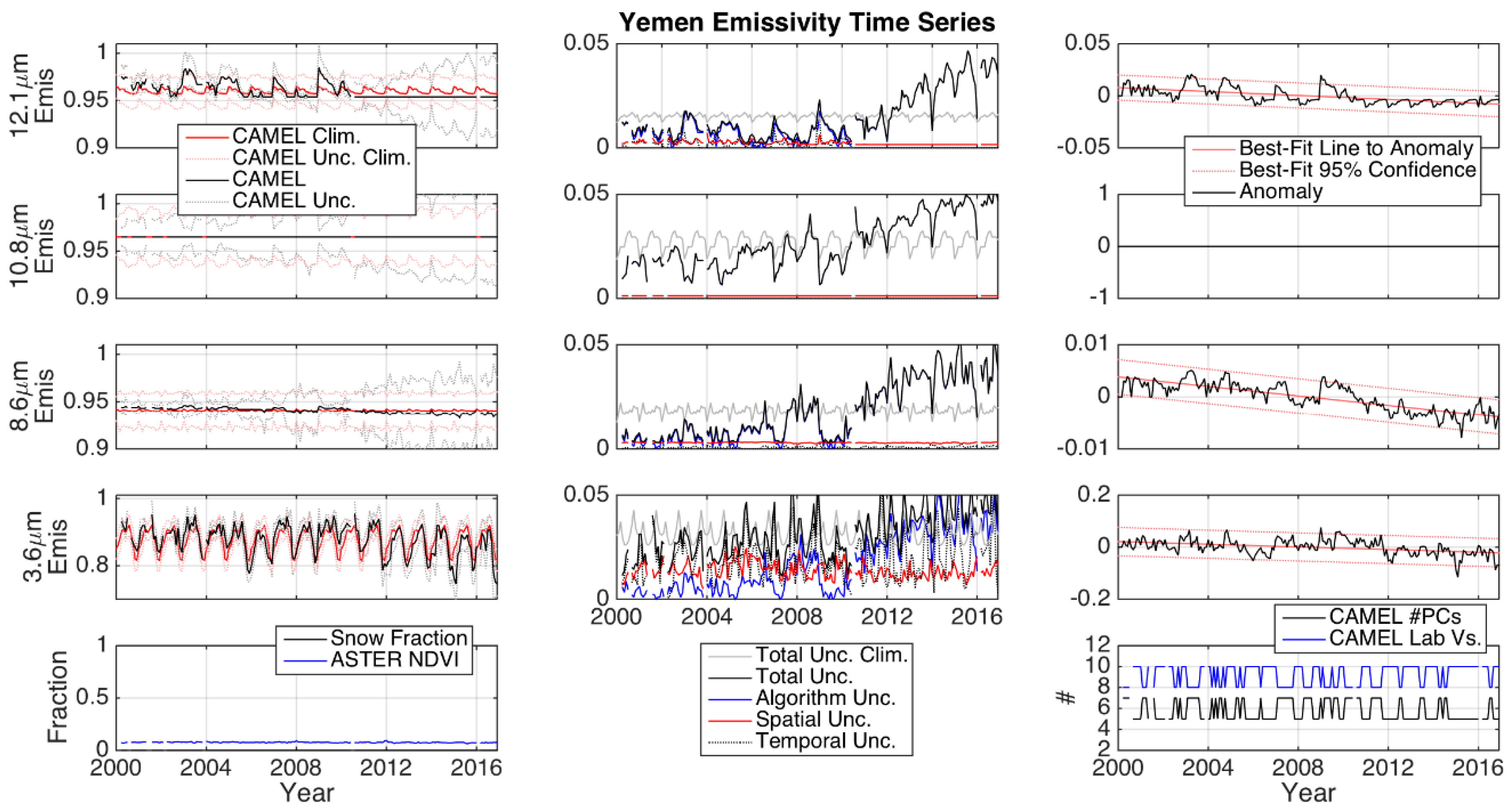
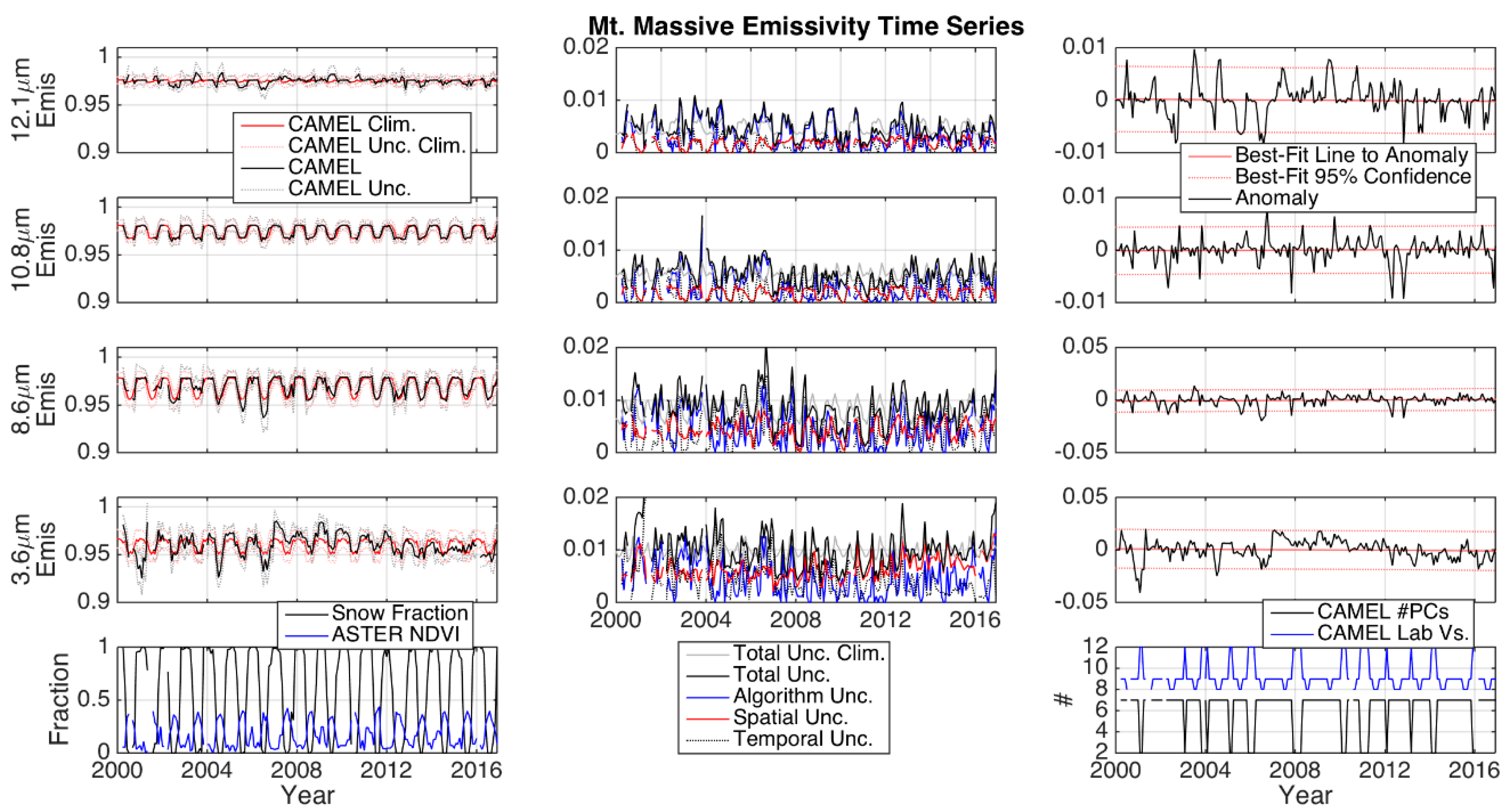



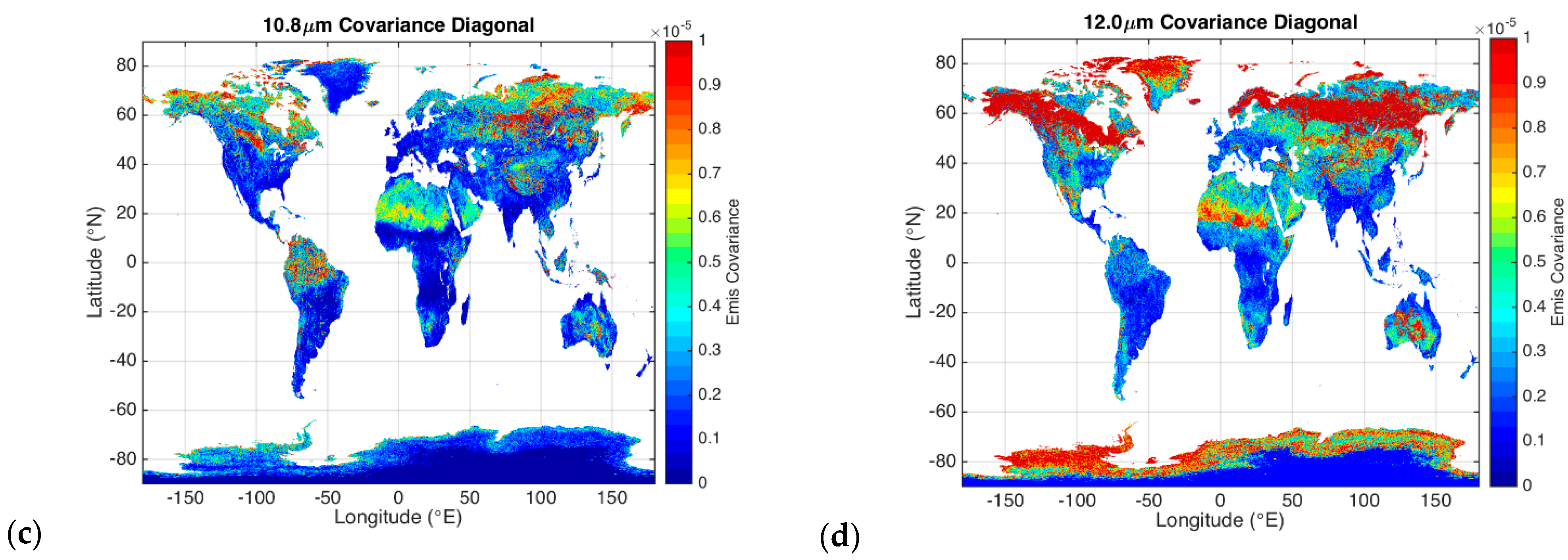
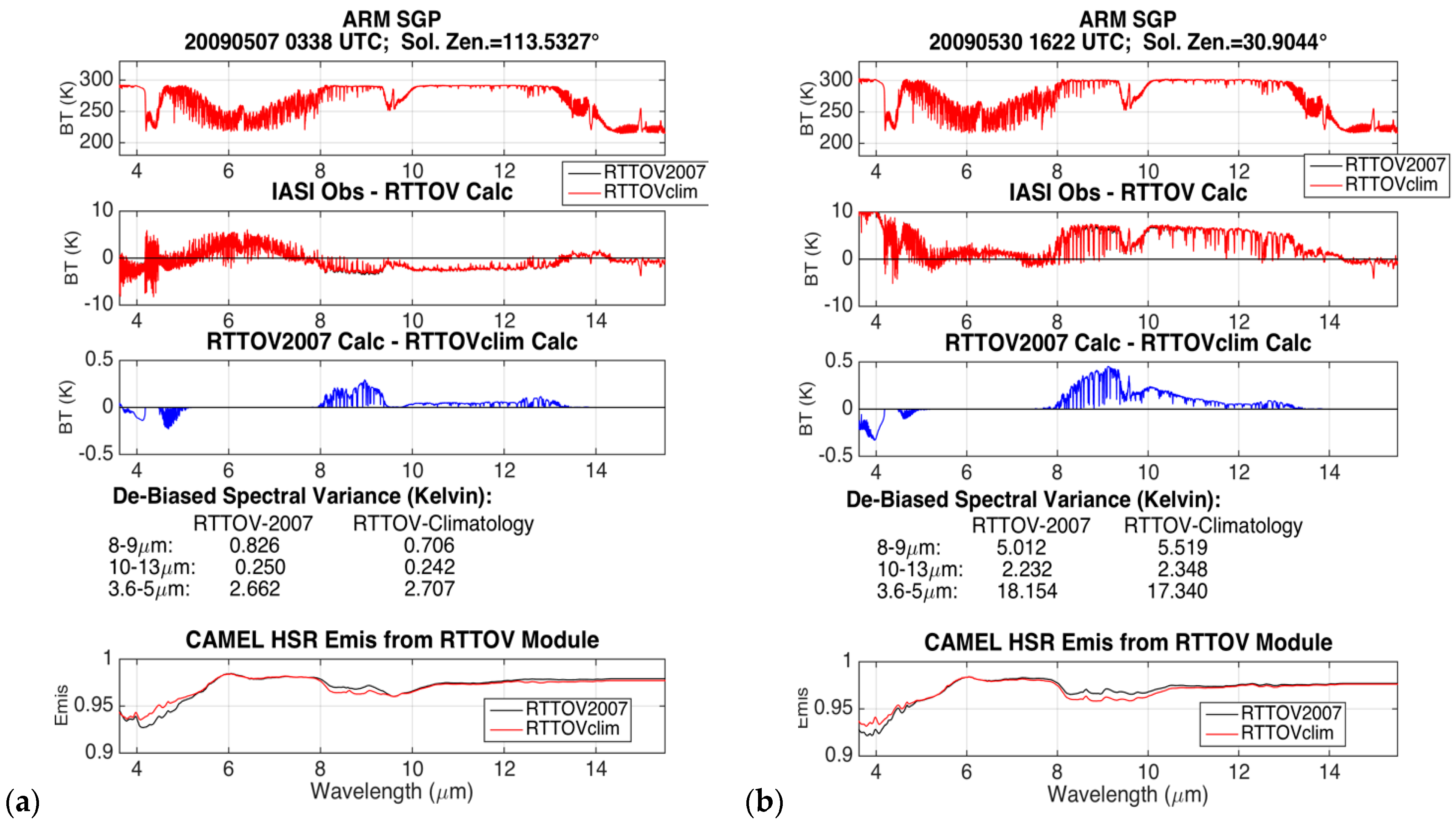

| Lab Version | Description | Number of Lab Spectra | Number of PCs | Snow Fraction |
|---|---|---|---|---|
| V8.3 | General—bare (quartz) General—all types | 55 | 9 7 | =0 =0 |
| V9.3 * | General + Snow/Ice—bare (quartz) General + Snow/Ice—all types | 55 + 4 | 9 7 | 0 < … < 1 0 < … < 1 |
| V10.3 | General + Carbonates | 82 | 5 | =0 |
| V11.3 * | General + Carbonates + Snow/Ice | 82 + 4 | 5 | 0 < … < 1 |
| V12.3 | Snow/Ice | 4 | 2 | =1 |
| Unique Combinations of Lab Version and Number of PCs | |||||||
|---|---|---|---|---|---|---|---|
| Lab Version | 12 | 10 | 11 | 8 | 8 | 9 | 9 |
| Number of PCs | 2 | 5 | 5 | 7 | 9 | 7 | 9 |
| CAMEL 2007 | CAMEL Clim | CAMEL 2007 | CAMEL Clim | CAMEL 2007 | CAMEL Clim | CAMEL 2007 | CAMEL Clim | |
|---|---|---|---|---|---|---|---|---|
| January 15th 2008 | April 14th 2008 | July 15th 2008 | September 29th 2008 | |||||
| 1: Evg. Needle Forest | 0.51 | 0.50 | 0.39 | 0.33 | 0.93 | 0.92 | 0.47 | 0.46 |
| 2: Evg. Broad Forest | 0.83 | 0.83 | 0.79 | 0.77 | 0.94 | 0.93 | 0.58 | 0.57 |
| 3: Dcds. Needle Forest | 0.46 | 0.42 | 0.53 | 0.57 | 1.30 | 1.30 | 0.25 | 0.24 |
| 4: Dcds. Broad Forest | 0.43 | 0.42 | 0.52 | 0.50 | 0.70 | 0.69 | 0.77 | 0.77 |
| 5: Mixed Forest | 0.37 | 0.32 | 0.33 | 0.27 | 0.94 | 0.93 | 0.46 | 0.45 |
| 6: Closed Shrubs | 0.48 | 0.51 | 1.00 | 1.01 | 0.93 | 0.93 | 1.02 | 1.01 |
| 7: Open Shrubs | 0.52 | 0.53 | 0.60 | 0.60 | 0.65 | 0.65 | 0.51 | 0.50 |
| 8: Woody Savanna | 0.5 | 0.51 | 0.71 | 0.70 | 0.79 | 0.79 | 0.71 | 0.70 |
| 9: Savanna | 0.65 | 0.67 | 0.77 | 0.78 | 0.66 | 0.66 | 0.6 | 0.59 |
| 10: Grassland | 0.51 | 0.50 | 0.62 | 0.64 | 0.73 | 0.74 | 0.50 | 0.50 |
| 11: Wetland | 0.35 | 0.36 | 0.23 | 0.24 | 0.76 | 0.76 | 0.46 | 0.45 |
| 12: Cropland | 0.47 | 0.47 | 0.46 | 0.44 | 0.66 | 0.65 | 0.59 | 0.58 |
| 13: Urban Area | 0.74 | 0.72 | 0.67 | 0.70 | 0.89 | 0.88 | 0.78 | 0.77 |
| 14: Crop Mosaic | 0.53 | 0.52 | 0.67 | 0.66 | 0.63 | 0.63 | 0.68 | 0.67 |
| 15: Antarctic/Snow | 0.25 | 0.21 | 0.21 | 0.19 | 0.32 | 0.31 | 0.31 | 0.29 |
| 16: Barren/Desert Land | 0.57 | 0.56 | 0.68 | 0.68 | 0.79 | 0.78 | 0.44 | 0.42 |
| 18: Tundra | 0.24 | 0.28 | 0.45 | 0.47 | 1.46 | 1.45 | 0.46 | 0.43 |
| CAMEL 2007 | CAMEL Clim | CAMEL 2007 | CAMEL Clim | CAMEL 2007 | CAMEL Clim | CAMEL 2007 | CAMEL Clim | |
|---|---|---|---|---|---|---|---|---|
| January 15th 2008 | April 14th 2008 | July 15th 2008 | September 29th 2008 | |||||
| 1: Evg. Needle Forest | 3.50 | 3.48 | 1.86 | 1.83 | 5.31 | 5.23 | 2.34 | 2.34 |
| 2: Evg. Broad Forest | 4.99 | 5.01 | 5.22 | 5.18 | 5.94 | 5.94 | 3.03 | 3.04 |
| 3: Dcds. Needle Forest | 2.22 | 2.23 | 5.94 | 5.78 | 9.25 | 9.07 | 1.28 | 1.31 |
| 4: Dcds. Broad Forest | 2.20 | 2.23 | 2.19 | 2.25 | 3.28 | 3.16 | 4.13 | 4.15 |
| 5: Mixed Forest | 1.95 | 1.93 | 1.38 | 1.41 | 5.26 | 5.09 | 2.34 | 2.32 |
| 6: Closed Shrubs | 2.07 | 2.07 | 4.41 | 4.50 | 4.95 | 4.76 | 5.29 | 5.28 |
| 7: Open Shrubs | 2.62 | 2.52 | 2.58 | 2.62 | 2.29 | 2.20 | 1.91 | 1.86 |
| 8: Woody Savanna | 2.87 | 2.84 | 4.09 | 4.07 | 4.74 | 4.64 | 2.92 | 2.90 |
| 9: Savanna | 2.89 | 2.84 | 3.68 | 3.69 | 3.87 | 3.76 | 2.12 | 2.01 |
| 10: Grassland | 2.45 | 2.38 | 2.95 | 3.15 | 2.18 | 2.16 | 1.96 | 1.96 |
| 11: Wetland | 1.69 | 1.68 | 1.27 | 1.25 | 3.32 | 3.28 | 2.73 | 2.64 |
| 12: Cropland | 2.64 | 2.60 | 2.17 | 2.16 | 3.15 | 3.09 | 2.96 | 2.94 |
| 13: Urban Area | 2.67 | 2.77 | 3.05 | 3.35 | 5.09 | 5.16 | 3.55 | 3.66 |
| 14: Crop Mosaic | 3.22 | 3.17 | 2.98 | 3.02 | 3.58 | 3.46 | 3.44 | 3.40 |
| 15: Antarctic/Snow | 1.28 | 1.28 | 1.16 | 1.17 | 1.54 | 1.56 | 1.80 | 1.83 |
| 16: Barren/Desert Land | 3.02 | 2.96 | 3.03 | 3.00 | 2.79 | 2.75 | 1.90 | 1.86 |
| 18: Tundra | 0.83 | 0.83 | 3.80 | 3.75 | 8.78 | 8.63 | 2.80 | 2.84 |
| CAMEL 2007 | CAMEL Clim | CAMEL 2007 | CAMEL Clim | CAMEL 2007 | CAMEL Clim | CAMEL 2007 | CAMEL Clim | |
|---|---|---|---|---|---|---|---|---|
| January 15th 2008 | April 14th 2008 | July 15th 2008 | September 29th 2008 | |||||
| 1: Evg. Needle Forest | 27.90 | 27.90 | 2.13 | 2.14 | 2.88 | 2.83 | 2.86 | 2.84 |
| 2: Evg. Broad Forest | 3.68 | 3.66 | 5.41 | 5.34 | 5.32 | 5.27 | 2.28 | 2.23 |
| 3: Dcds. Needle Forest | 187.00 | 186.00 | 15.60 | 15.30 | 5.80 | 5.52 | 2.25 | 2.20 |
| 4: Dcds. Broad Forest | 37.10 | 37.00 | 2.39 | 2.41 | 2.59 | 2.48 | 3.50 | 3.47 |
| 5: Mixed Forest | 82.60 | 82.50 | 1.94 | 1.94 | 3.33 | 3.20 | 2.94 | 2.89 |
| 6: Closed Shrubs | 25.50 | 25.50 | 5.04 | 4.95 | 3.00 | 2.90 | 2.75 | 2.70 |
| 7: Open Shrubs | 23.20 | 23.10 | 3.61 | 3.51 | 1.94 | 1.80 | 2.04 | 1.99 |
| 8: Woody Savanna | 87.00 | 86.90 | 4.53 | 4.47 | 3.48 | 3.38 | 2.48 | 2.43 |
| 9: Savanna | 2.85 | 2.88 | 2.89 | 2.81 | 3.32 | 3.20 | 1.66 | 1.59 |
| 10: Grassland | 20.30 | 20.20 | 2.80 | 2.76 | 2.21 | 2.16 | 2.20 | 2.14 |
| 11: Wetland | 92.20 | 92.10 | 15.10 | 15.10 | 3.00 | 2.95 | 2.79 | 2.73 |
| 12: Cropland | 8.81 | 8.83 | 2.75 | 2.71 | 2.92 | 2.86 | 2.94 | 2.88 |
| 13: Urban Area | 2.80 | 2.82 | 2.19 | 2.32 | 3.94 | 3.88 | 2.95 | 2.98 |
| 14: Crop Mosaic | 10.90 | 10.90 | 2.71 | 2.69 | 3.22 | 3.13 | 2.76 | 2.69 |
| 15: Antarctic /Snow | 281.00 | 281.00 | 175.00 | 175.00 | 129.00 | 129.00 | 114.00 | 114.00 |
| 16: Barren/Desert Land | 3.71 | 3.55 | 1.70 | 1.56 | 1.91 | 1.79 | 2.08 | 1.95 |
| 18: Tundra | 69.40 | 69.30 | 21.60 | 21.60 | 10.20 | 10.80 | 4.32 | 4.36 |
Publisher’s Note: MDPI stays neutral with regard to jurisdictional claims in published maps and institutional affiliations. |
© 2020 by the authors. Licensee MDPI, Basel, Switzerland. This article is an open access article distributed under the terms and conditions of the Creative Commons Attribution (CC BY) license (http://creativecommons.org/licenses/by/4.0/).
Share and Cite
Loveless, M.; Borbas, E.E.; Knuteson, R.; Cawse-Nicholson, K.; Hulley, G.; Hook, S. Climatology of the Combined ASTER MODIS Emissivity over Land (CAMEL) Version 2. Remote Sens. 2021, 13, 111. https://doi.org/10.3390/rs13010111
Loveless M, Borbas EE, Knuteson R, Cawse-Nicholson K, Hulley G, Hook S. Climatology of the Combined ASTER MODIS Emissivity over Land (CAMEL) Version 2. Remote Sensing. 2021; 13(1):111. https://doi.org/10.3390/rs13010111
Chicago/Turabian StyleLoveless, Michelle, E. Eva Borbas, Robert Knuteson, Kerry Cawse-Nicholson, Glynn Hulley, and Simon Hook. 2021. "Climatology of the Combined ASTER MODIS Emissivity over Land (CAMEL) Version 2" Remote Sensing 13, no. 1: 111. https://doi.org/10.3390/rs13010111
APA StyleLoveless, M., Borbas, E. E., Knuteson, R., Cawse-Nicholson, K., Hulley, G., & Hook, S. (2021). Climatology of the Combined ASTER MODIS Emissivity over Land (CAMEL) Version 2. Remote Sensing, 13(1), 111. https://doi.org/10.3390/rs13010111






